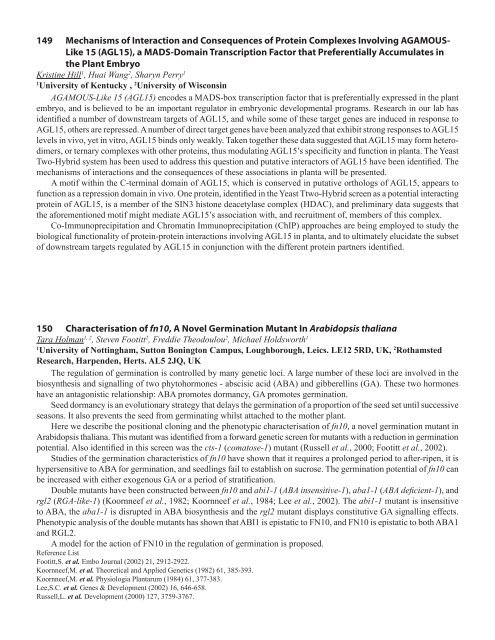75 Integrating Membrane Transport with Male Gametophyte ... - TAIR
75 Integrating Membrane Transport with Male Gametophyte ... - TAIR
75 Integrating Membrane Transport with Male Gametophyte ... - TAIR
Create successful ePaper yourself
Turn your PDF publications into a flip-book with our unique Google optimized e-Paper software.
149 Mechanisms of Interaction and Consequences of Protein Complexes Involving AGAMOUS-<br />
Like 15 (AGL15), a MADS-Domain Transcription Factor that Preferentially Accumulates in<br />
the Plant Embryo<br />
Kristine Hill 1 , Huai Wang 2 , Sharyn Perry 1<br />
1<br />
University of Kentucky , 2 University of Wisconsin<br />
AGAMOUS-Like 15 (AGL15) encodes a MADS-box transcription factor that is preferentially expressed in the plant<br />
embryo, and is believed to be an important regulator in embryonic developmental programs. Research in our lab has<br />
identified a number of downstream targets of AGL15, and while some of these target genes are induced in response to<br />
AGL15, others are repressed. A number of direct target genes have been analyzed that exhibit strong responses to AGL15<br />
levels in vivo, yet in vitro, AGL15 binds only weakly. Taken together these data suggested that AGL15 may form heterodimers,<br />
or ternary complexes <strong>with</strong> other proteins, thus modulating AGL15’s specificity and function in planta. The Yeast<br />
Two-Hybrid system has been used to address this question and putative interactors of AGL15 have been identified. The<br />
mechanisms of interactions and the consequences of these associations in planta will be presented.<br />
A motif <strong>with</strong>in the C-terminal domain of AGL15, which is conserved in putative orthologs of AGL15, appears to<br />
function as a repression domain in vivo. One protein, identified in the Yeast Ttwo-Hybrid screen as a potential interacting<br />
protein of AGL15, is a member of the SIN3 histone deacetylase complex (HDAC), and preliminary data suggests that<br />
the aforementioned motif might mediate AGL15’s association <strong>with</strong>, and recruitment of, members of this complex.<br />
Co-Immunoprecipitation and Chromatin Immunoprecipitation (ChIP) approaches are being employed to study the<br />
biological functionality of protein-protein interactions involving AGL15 in planta, and to ultimately elucidate the subset<br />
of downstream targets regulated by AGL15 in conjunction <strong>with</strong> the different protein partners identified.<br />
150 Characterisation of fn10, A Novel Germination Mutant In Arabidopsis thaliana<br />
Tara Holman 1, 2 , Steven Footitt 2 , Freddie Theodoulou 2 , Michael Holdsworth 1<br />
1<br />
University of Nottingham, Sutton Bonington Campus, Loughborough, Leics. LE12 5RD, UK, 2 Rothamsted<br />
Research, Harpenden, Herts. AL5 2JQ, UK<br />
The regulation of germination is controlled by many genetic loci. A large number of these loci are involved in the<br />
biosynthesis and signalling of two phytohormones - abscisic acid (ABA) and gibberellins (GA). These two hormones<br />
have an antagonistic relationship: ABA promotes dormancy, GA promotes germination.<br />
Seed dormancy is an evolutionary strategy that delays the germination of a proportion of the seed set until successive<br />
seasons. It also prevents the seed from germinating whilst attached to the mother plant.<br />
Here we describe the positional cloning and the phenotypic characterisation of fn10, a novel germination mutant in<br />
Arabidopsis thaliana. This mutant was identified from a forward genetic screen for mutants <strong>with</strong> a reduction in germination<br />
potential. Also identified in this screen was the cts-1 (comatose-1) mutant (Russell et al., 2000; Footitt et al., 2002).<br />
Studies of the germination characteristics of fn10 have shown that it requires a prolonged period to after-ripen, it is<br />
hypersensitive to ABA for germination, and seedlings fail to establish on sucrose. The germination potential of fn10 can<br />
be increased <strong>with</strong> either exogenous GA or a period of stratification.<br />
Double mutants have been constructed between fn10 and abi1-1 (ABA insensitive-1), aba1-1 (ABA deficient-1), and<br />
rgl2 (RGA-like-1) (Koornneef et al., 1982; Koornneef et al., 1984; Lee et al., 2002). The abi1-1 mutant is insensitive<br />
to ABA, the aba1-1 is disrupted in ABA biosynthesis and the rgl2 mutant displays constitutive GA signalling effects.<br />
Phenotypic analysis of the double mutants has shown that ABI1 is epistatic to FN10, and FN10 is epistatic to both ABA1<br />
and RGL2.<br />
A model for the action of FN10 in the regulation of germination is proposed.<br />
Reference List<br />
Footitt,S. et al. Embo Journal (2002) 21, 2912-2922.<br />
Koornneef,M. et al. Theoretical and Applied Genetics (1982) 61, 385-393.<br />
Koornneef,M. et al. Physiologia Plantarum (1984) 61, 377-383.<br />
Lee,S.C. et al. Genes & Development (2002) 16, 646-658.<br />
Russell,L. et al. Development (2000) 127, 3<strong>75</strong>9-3767.





